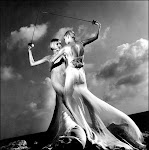
My mother once told me I came out of her womb clutching. "Your hands," she said to me, "Were so tiny, but they were so strong. They'd grab on to anything within reach and hang on. I had the hardest time getting you to let go."
Nothing was safe, she said. As an infant it was her hair. The collar of her shirt. The locket she wore most of her life and which I now wear on a regular basis as well. As I got older and started to move around, I'd latch on to whatever happened to catch my attention for that day—a blanket, a book, one of my mother's nicknacks, utensils (apparently I was very fond of spoons) and carry that object with me for the duration of the day, letting go only in sleep, and sometimes not even then. That bear up there, it was the first among many that my father bought me in an attempt to keep me from pilfering his tools.
As I got a little older, I started to collect things. Rocks. Bits of animal bone, wildflowers, and the discarded soda bottles that littered the land surrounding the ranch where I grew up. Once, while walking with my mother, I found the molted skin of a rattlesnake, nearly whole, translucent like rice paper and just as fragile. I begged my mother to let me take it home and she finally agreed. She, too, understood the tug of objects and so I brought it home and put it in the garden where it remained for a few days until my brother came along and ripped it to shreds. My brother was always,
always messing with my stuff. He knew it was the one button he could push that would send me nuclear (I eventually lost that bear up there because he tossed it into the fire.) and few things in life gave him quite the same pleasure as sending me nuclear.
Fast forward to present day. I still clutch and collect. I can't help it. Materialism is as firmly encoded in my DNA as my eye color. Most humans, too, probably. Last time I checked, our species wasn't living in some Star Trek episode, reduced to pure brain matter, our bodies long discarded just like that snake skin, the effluence of a burdensome and ultimately useless organic existence. Last time I checked, we humans remain resolutely material ourselves, as solidly situated in time and space as that rock over there, even though, like the planet itself, we are about 75 percent water. Still, we cannot walk through walls or use our minds to shift objects.
So, I wonder: What are we at this point in our evolutionary history, if
not a species evolved to make, to trade, to covet, to collect? And, by extension, what could be more important to our history than the stories told by the objects we make?
Of all the things I have collected over the years, I think this piece tells one of my favorite stories. I bought it two summers ago at the International Folk Art Market in Santa Fe from
Zimbabwe story quilt artist
Elizabeth Savanhu.

Because most Weyan quilt artists produce their work as part of a collective, their individual names usually remain anonymous. Elizabeth, however, had for some reason been singled out by the fair organizers. I was immediately drawn to her work and spent quite a bit of time speaking with her. This was her first-ever trip outside her village. In addition to the excitement of the plane ride over, she also got to spend two days in New York City before continuing on to Santa Fe, which she found to be very beautiful, too, but was wondering how two such different cities could exist in one country?
Elizabeth had so many beautiful quilts of all sizes that I was having a hard time deciding which one to buy. Eventually, it was the figure of the dog in this one that made up my mind. He is, Elizabeth told me, her favorite dog out of the three that her family cares for and so she gave him a place of prominence in two of the quilt's panels.
The first thing I did when I got home that evening was hang the quilt on a section of wall in my office, but it wasn't until the next morning that I actually noticed the smell of smoke. Not cigarette smoke, but more like the smell of burnt wood. It took me a few minutes to get it: the smoke smell was coming from the quilt. And it was coming from the quilt because most likely the only light available in Elizabeth's village after the sun went down was from campfires.
That was where she would sit, in the evenings after school and after chores and dinner: in front of a campfire in the middle of Africa, in a place so far removed from my life in America that it may as well be on the moon, making this object of beauty that she carried with her across an ocean and two continents, whose smell of smoke was not the gap between Africa and me, but the bridge, so that I could know and understand the story of Elizabeth and she could know and understand the story of me, always clutching.
















